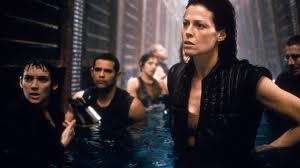“In space, no one can hear you scream…”
Recently, a close friend of mine had just watched Alien for the very first time in order to build anticipation for next’s month’s Prometheus. He confessed that, although he enjoyed it, the film did not scare the crap out of him. He was aware that a disgusting creature would erupt out of John Hurt’s chest well before he popped in the DVD.
Alien‘s success has become a double-edged sword: Its popularity has diluted its impact. The film is now so deeply embedded in the cultural spectrum that it no longer carries the same surprise element that sent movie-goers into shock convulsions during its debut in 1979. Many copycat horror films have followed (monster discovered, runs ramped, wipes out a bevy of people, and is finally destroyed by a lone survivor before the credits roll) hoping to repeat its success. The monster-loose-on-a-spaceship soon became cliche’ as masked killers with knives. Even the film’s most famous sequence–the “birth”–has been parodied and referenced in almost every conceivable medium. Unless you are blind, deaf or an alien yourself, you know this sequence.

Despite the now-predictable grandiose entrance of the antagonist, Alien remains a classic above almost all films in the genre. Originally conceived as a cheap B-movie, Roger Corman knockoff, Alien was given the red carpet treatment after an earlier sci-fi epic, Star Wars, soared past box office records. However, the director, Ridley Scott, borrowed more ingredients from 2001: his outer space is desolate, slow, lonely, and frightening. Even the ship’s central computer, MU-TH-ER, hearkens back to HAL.
Scott took an already familiar monster-movie premise and invigorated it with a new sense of realism, seriousness and dread. Also, very few horror features–then or now–contain the same consideration for the human cast or the build-up between attack sequences.
Let’s consider the film’s opening–which wouldn’t pass with today’s studios lack of faith in audience attention spans. Alien doesn’t start with a bang, but with a subtle hum. A huge space carrier is shown trans-versing the bleakness space. Jerry Goldsmith’s eerie credit music is suggestive enough to reveal that this will be a horror movie.
The camera creeps slowly around ship’s foreboding passages, establishing the vastness of its interior and establishes many possibilities where the not-yet-introduced villain could hide. With a whisper, the ship’s hyper sleep chamber opens and the seven members of the crew begin to wake up, after months of slumber during their return voyage. When Kain (John Hurt) slowly rises, it’s subtlety communal, almost symbolic when you consider his ultimate fate.
In a standard Hollywood film, each of the seven characters would be presented in series of closeups and brief dialog that touches on their histories. Scott wastes no time on that. The crew is introduced eating breakfast in a series of long-shots having a mundane conversation on the imbalance in pay distribution. Even in outer space, class warfare exists. These folks aren’t glorified heroes–they’re grunt workers, eager to get home and take some R&R.
Before the payment debate is settled, MU-TH-ER reveals that the ship hasn’t returned to earth, but was diverted to investigate an alien transmission from an uninhabited planet. When the crew investigates, they unknowingly carry an intruder–gestating inside Kain’s chest.
Alien has one of the finest ensembles in a genre that typically limits the characters as fodder for the monster. Although the film doesn’t establish individual story arch or backgrounds, Scott allows the brief interactions between the characters to invoke remarkable realism and intrigue. In one scene, Ripley (Sigourney Weaver) makes promises to the technical grunts (Yaphet Kott and Harry Dean Stanton) that they will earn a share of the bonus, much to their doubt and bemusement. The moment she’s out of earshot, they talk shit. When the alien appears and begins taking out crew members, they sure as hell listen to Ripley.
The seven castmates should be familiar to today’s audiences: Ian Holm, as the cryptic medical officer, Tom Skerritt, as the laid-back commander, Hurt as Kain, Kotto and Stanton (recently scene-stealing the “Avengers” by warning Bruce Banner of his “serious condition”) as the ship’s disgruntled tech crew.
If Weaver was not the poster child for the Alien franchise, most first-time viewers would not easily guess that she would become the ultimate “hero”. Weaver’s presents Ripley as a thorn in the side of her crew, arguing for following quarantine rules rather than allowing the unconscious Kain (possessing the alien fetus) into the ship. If the other crew members listened, they would be alive–and there would be no franchise.
Although the actual alien doesn’t make an “appearance” until the film’s mid-way point, the anticipation and suspense builds. Scott leisurely hints at the characters’ worries without having them explain themselves. When the space ship first arrives on the planet, the crew are making plans to walk on foot and explore the planet. However, Lambert (Veronica Cartwright) is shown in a close-up sitting and smoking a cigarette while in deep thought. What is she thinking? Most directors would concentrate the camera on their conversation between the characters talking, but Scott constantly cuts back to Lambert, suggesting her inhibitions–suspecting that something bad is going to happen.
When Kain, Dallas and Lambert explore the planet surface, the atmosphere is eerie. There are no fake scares, just the suggestion that danger lurks.
When the alien finally appears (in the most famous of birth sequences), he quickly vanishes, leaving the surviving crew members look for it. At one point, Brent wonders alone (we know what happens next). Although, this scene is the most obvious and cliched, it’s still effective due to the suspense Scott instills. He again takes his time.
Brent moves further in the bowels of the ship. The dripping moisture, clinking of chains and the subtle sounds of a racing heartbeat suggest that he’s in danger. Scott invokes the Hitchcock formula: The audience knows something bad will happen, but the suspense comes from waiting and the build until it actually occurs.
After the alien dispatches of three crew members, the survivors begin to unravel. The actors react in realistic behavioral patterns: one wants to flee, another wants revenge, and another a secret motivation entirely.
Alien stands apart from the films that follows the most. It’s formula has been copied, but never replicated. No film today would allow a monster movie to invoke as much patience and suggestions of terror without actually showing it.
Scott allowed Alien to build–the suspense boils over at the point when alien finally strikes. Many elements of fear are effectively invoked, such as the sense of claustrophobia as Dallas hunts the alien through the dark, cramped venting system, or the double jeopardy when Ripley rushes to evacuate the ship before it self-destructs, except the alien is lurking somewhere between her and the escape pod.
If Alien were made today, the film-makers would forgo the opening credits and ambiance in order to tease a few seconds of Ripley running in terror in the third act. There would be no faith in the audience’s patience or the capacity of their imagination.
As for the creature itself, it has become as iconic as Dracula or Frankenstein. The original poster artwork reveals nothing of the alien’s appearance (in any of its incantations), which serves the story better. Even throughout the course of the film, we never really see the alien, except for quick cuts. It’s origins, weaknesses and motives are not explored–it’s just a perfect killing machine. Once again referencing Hitchcock, we don’t care about any of this information. All that matters, is that if it spots you, it will kill you! Our imagination does the rest.
The Prometheus Factor
Like many, I am eager to see Ridley Scott return to the Alien saga. I have doubts that the film will compare to the original in terms of imagination and suspense. There will be many moments that harken back to the original feature. Of course, the film takes place on the planet where the Alien was discovered in the original film. The cast of this new film features many beautiful actors. Sigourney Weaver was no dog in Alien but she was still believable as a space trucker. Charlize Theron is not so believable. But this isn’t 1979.
Up next…
“They mostly come out at night…mostly…”





















